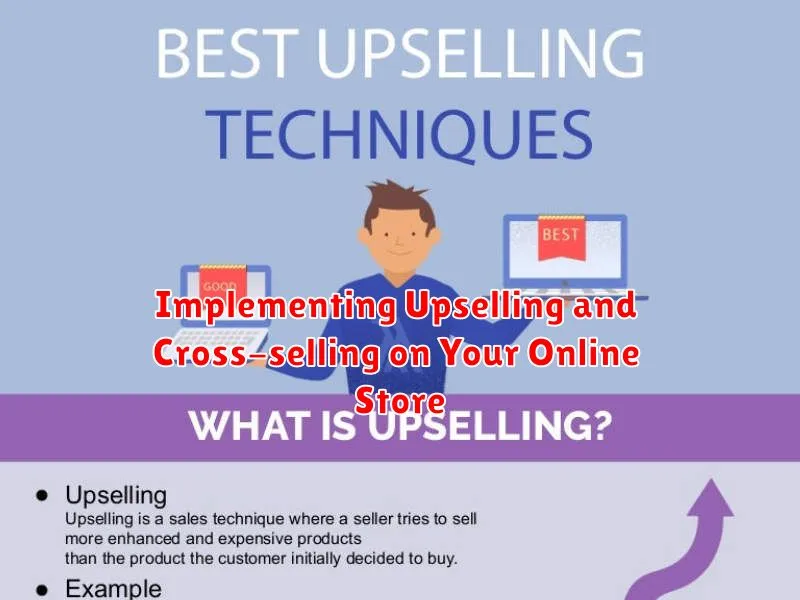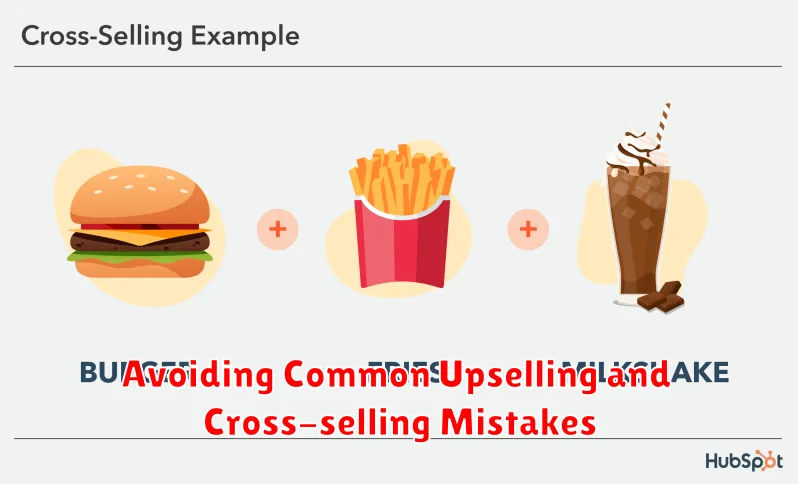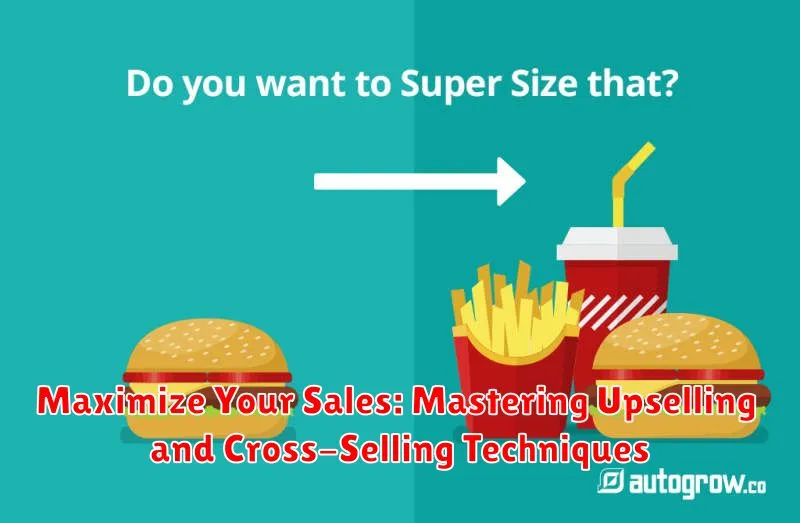In today’s competitive market, simply making a sale isn’t enough. To truly thrive, businesses must focus on maximizing revenue from each customer interaction. This is where upselling and cross-selling techniques become essential. Mastering these strategies can significantly impact your bottom line, driving higher average order values and fostering stronger customer relationships. This article will delve into the nuances of upselling and cross-selling, providing actionable strategies and practical examples to help you unlock your sales potential.
Whether you’re running an e-commerce store, managing a sales team, or operating a brick-and-mortar business, understanding the difference between upselling (persuading a customer to purchase a higher-value version of the product they’re already considering) and cross-selling (suggesting complementary products) is paramount. By strategically implementing these techniques, you can not only increase your sales but also enhance customer satisfaction by offering tailored solutions that meet their needs. Learn how to effectively implement upselling and cross-selling strategies to maximize your sales and cultivate lasting customer loyalty.
Understanding Upselling and Cross-selling
Upselling and cross-selling are powerful sales techniques that encourage customers to purchase more, ultimately increasing your average order value. While both aim to boost sales, they differ in their approach.
Upselling focuses on persuading a customer to purchase a higher-end version of the product they’re already considering. This could involve suggesting a premium model with additional features, a larger size, or a more comprehensive package. The goal is to increase the value of their individual purchase by offering a superior alternative.
Cross-selling, on the other hand, involves suggesting related or complementary products to a customer’s existing selection. This could include recommending accessories, add-ons, or other items that enhance the primary product’s functionality or value. The focus here is on increasing the overall number of items in the customer’s cart.
Both upselling and cross-selling are valuable strategies when implemented effectively. They rely on understanding customer needs and offering relevant suggestions that enhance their overall experience.
Identifying Upselling and Cross-selling Opportunities
Identifying opportune moments for upselling and cross-selling is crucial for maximizing their effectiveness. This involves a deep understanding of your product catalog and your customer’s needs. Start by analyzing your product data.
Product Analysis
Group products that complement each other or offer enhanced features. For example, if a customer is viewing a basic camera, a higher-resolution model with additional lenses would be a prime upselling opportunity. Similarly, a camera bag, tripod, or extra battery could be cross-selling opportunities.
Customer Behavior Analysis
Understanding customer behavior is equally important. Analyze purchase history and browsing patterns to identify potential upsells and cross-sells. If a customer frequently purchases running shoes, consider suggesting premium insoles or performance apparel as an upsell. If they are browsing fitness trackers, cross-selling related accessories like heart rate monitors could prove beneficial.
Consider Product Bundles
Creating product bundles can be a powerful way to present both upselling and cross-selling opportunities. Offer a slightly discounted price for purchasing complementary items together, incentivizing customers to spend more while fulfilling their needs.
Implementing Upselling and Cross-selling on Your Online Store

Effective implementation of upselling and cross-selling strategies requires careful planning and integration within your online store. A key element is the strategic placement of offers. Consider using product page placements for upsells, showcasing premium versions or add-ons related to the item being viewed.
For cross-selling, cart page placements are highly effective. Present complementary products to shoppers as they finalize their purchase decisions. Pop-up windows can also be utilized, but exercise caution to avoid disrupting the user experience. Ensure pop-ups are strategically timed and offer genuine value.
Optimize your product descriptions to highlight the benefits of upgraded versions and related items. Use clear and concise language to explain the value proposition. Employ visual cues, such as highlighting upsell and cross-sell offers with distinct colors or banners.
Finally, remember to A/B test different placements and messaging to determine the most effective strategies for your specific customer base.
Crafting Effective Upselling and Cross-selling Offers
Crafting compelling upselling and cross-selling offers involves understanding customer needs and presenting relevant products. Value is the key. Clearly demonstrate how the additional or upgraded product enhances their initial purchase.
Highlight the benefits, not just the features. Focus on how the offered product solves a problem, improves performance, or adds convenience. For example, instead of simply saying “This camera has more megapixels,” explain how those extra megapixels translate to sharper, more detailed photos.
Keep the price increase reasonable for upsells. A small jump in price for a significant upgrade is more palatable than a large price difference. For cross-sells, suggest complementary items that enhance the overall purchase experience.
Use clear and concise language. Avoid jargon and technical terms that might confuse the customer. Explain the offer simply and directly, emphasizing the added value it brings.
Create a sense of urgency or scarcity, where appropriate. Limited-time offers or limited stock can encourage customers to act quickly. However, use these tactics sparingly to maintain trust and avoid appearing manipulative.
Using Product Recommendations to Drive Sales
Product recommendations are a powerful tool for boosting sales by suggesting relevant items to customers. By leveraging data and customer behavior, you can personalize these recommendations for maximum impact.
Data-driven recommendations utilize browsing history, purchase patterns, and even demographic information to present items customers are likely interested in. This targeted approach increases the chances of conversion.
Several effective methods for implementing product recommendations exist. “Frequently bought together” suggestions highlight items commonly purchased in conjunction with the product being viewed. “Customers who bought this item also bought” recommendations leverage the wisdom of the crowd to showcase popular related products. Finally, personalized recommendations based on individual browsing history provide a truly tailored shopping experience.
By strategically incorporating product recommendations on your online store, you can enhance the customer journey and drive additional sales.
Measuring the Success of Your Upselling and Cross-selling Efforts
Tracking the right metrics is crucial to understanding the effectiveness of your upselling and cross-selling strategies. By monitoring these key performance indicators (KPIs), you can identify areas for improvement and optimize your approach for maximum impact.
Key Metrics to Track:
- Upselling/Cross-selling Conversion Rate: This measures the percentage of customers who accept an upsell or cross-sell offer. A higher conversion rate indicates successful persuasion techniques and relevant product recommendations.
- Average Order Value (AOV): Track how upselling and cross-selling impact your AOV. A significant increase suggests your strategies are effectively boosting sales revenue per customer.
- Revenue Generated from Upselling/Cross-selling: Calculate the total revenue directly attributable to these techniques. This metric highlights the overall financial contribution of your efforts.
- Product Affinity: Analyze which products are frequently purchased together. This data informs more targeted cross-selling recommendations and personalized customer experiences.
Regularly analyzing these KPIs will provide valuable insights into the success of your upselling and cross-selling initiatives, enabling you to refine your techniques and maximize your sales potential.
Avoiding Common Upselling and Cross-selling Mistakes

While upselling and cross-selling are powerful techniques, misapplication can damage customer relationships. Avoid these common pitfalls:
Being Too Pushy
Aggressive sales tactics often backfire. Focus on offering genuine value and relevant solutions, not just increasing the order value. Respect customer hesitations and don’t push products they clearly don’t need.
Ignoring Customer Needs
Relevance is key. Upsells and cross-sells must align with the customer’s original purchase and their individual needs. An irrelevant offer can feel forced and damage trust.
Upselling Too Early
Build rapport first. Premature upselling before understanding customer needs can appear opportunistic. Establish trust before presenting additional offers.
Overwhelming the Customer
Keep it simple. Presenting too many options can confuse and overwhelm customers. Focus on a few strategic recommendations to avoid decision fatigue.

